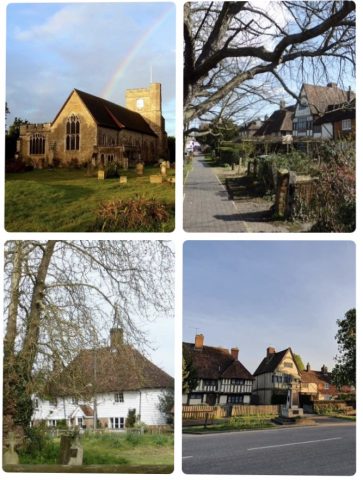Headcorn lies in the scenic Low Weald of Kent. It is a unique landscape area with many small and pretty villages and a countryside consisting of small woodland, or copse areas and many farms with small fields and ancient hedgerows. The village is situated near to the river Beult, which runs to the south and is designated as a Site of Special Scientific Interest (SSSI).
The village has a considerable historic background, but prides itself in keeping up with today’s developments. The centre of Headcorn keeps much of its old charm even though most of the shops and businesses have changed hands over the years.
The village prides itself in its friendliness to all-comers.
The earliest written records are references in charters of King Wihtred to Wick Farm, 724 and King Offa to Little Southernden, 785.
Headcorn probably started at the time of the Kingdom of Kent as a clearing, to which pigs were driven from the northern parts of the County to feed on acorns etc. in the Wealden Forest.
Headcorn does not figure in the Domesday Book of 1086, however the Domesday Monachorum, the ecclesiastical survey or the same time, records the existence of a Church at Hedekaruna. The name possibly means “tree-trunk (used as a footbridge) of a man called Hydeca.”
Henry of Ospringe was the first Rector in 1222 appointed by King Henry III, in 1239 the King gave Headcorn, with the rectorial endowments, to the Maison Dieu at Ospringe. In 1251 the Master and Brethren of Ospringe were granted a weekly market on Thursdays and an annual fair at Headcorn on St Peter and St Paul’s Day, the 29th June.
In 1482 the Ospringe house was dissolved and in 1516 St John’s College, Cambridge was given the Maison Dieu properties. The fair was then held on the 12th June, having apparently been merged with the trinity-tide fair of Moatenden Priory, located to the north of the village.
Headcorn was later made prosperous by the weaving industry established in the 14th and 15th centuries, as evidenced by Shakespeare House and the Cloth Hall built around this time.
In 1940, following the evacuation from Dunkirk, many thousands of British and Allied troops received their first meal in England at Headcorn Station. Up to 100 trains per day stopped here where local volunteers assisted the Royal Army Service Corps in providing refreshments.
The Aerodrome at Shenley Farm, served as an advanced landing ground for Canadians and then Americans in World War 2.
Today, as a private civil airfield and parachute centre, it also houses the Air Warfare Museum, the Air Cadets of 500 Squadron and a company that provides the chance to fly in a Spitfire! It gives a feel of how the Battle of Britain sounded.
The 1986 list of buildings of architectural or historic interest has 88 entries from Headcorn.
Longmeadow Hall was restored in 2000 as part of the Community Centre project.
The Village lies within a conservation area as outlined below.



